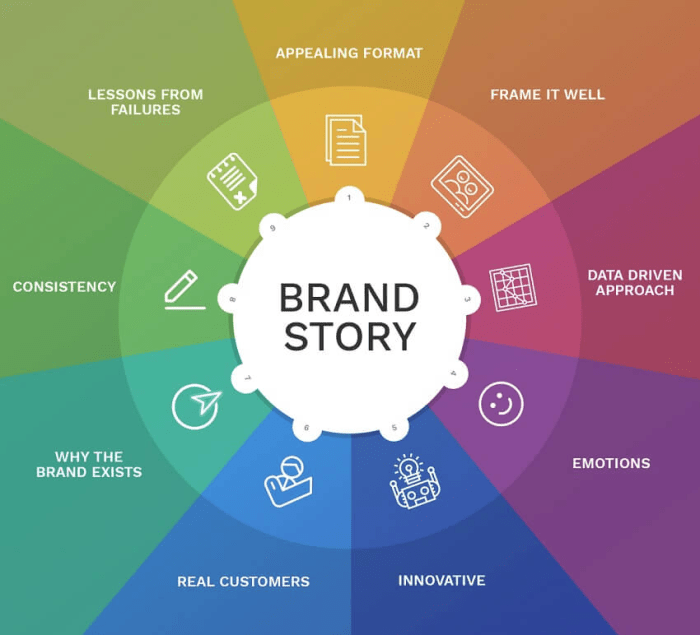Understanding Brand Storytelling takes us on a journey through the art of crafting captivating narratives that resonate with audiences, blending creativity and strategy seamlessly for maximum impact.
Get ready to explore the core elements, techniques, and success metrics of brand storytelling in a way that speaks to the essence of connecting brands with their consumers on a deeper level.
What is Brand Storytelling?

Brand storytelling is the strategic approach of using narratives to connect with customers on an emotional level, creating a memorable and authentic relationship between the brand and its audience.
Importance of Brand Storytelling in Marketing
Brand storytelling plays a crucial role in marketing by humanizing the brand, making it more relatable and engaging for consumers. It helps establish a unique identity for the brand, differentiate it from competitors, and build a loyal customer base.
- Brand storytelling creates an emotional connection: By sharing stories that resonate with the audience, brands can evoke emotions that lead to stronger relationships with customers.
- It builds brand trust and credibility: Through storytelling, brands can showcase their values, mission, and commitment, earning the trust of consumers who align with those principles.
- Brand storytelling sets brands apart: In a competitive market, storytelling can help brands stand out by highlighting what makes them unique and memorable.
Examples of Successful Brand Storytelling Campaigns
1. Nike’s “Just Do It” Campaign
Nike’s iconic slogan has become synonymous with empowerment and overcoming obstacles, inspiring athletes and non-athletes alike to push their limits.
2. Coca-Cola’s “Share a Coke” Campaign
Coca-Cola personalized its products by printing common names on bottles, encouraging people to share a Coke with loved ones and creating a sense of connection.
3. Airbnb’s “Belong Anywhere” Campaign
Airbnb’s brand story focuses on the idea of belonging anywhere in the world, promoting diversity, inclusivity, and cultural exchange through shared experiences.
Elements of Effective Brand Storytelling
Brand storytelling is all about creating a connection with your audience, and there are key elements that can make a brand story compelling. Let’s dive into what makes brand storytelling effective and how emotions play a crucial role in this strategy.
Key Elements of Compelling Brand Storytelling, Understanding Brand Storytelling
Effective brand storytelling involves several key elements that help capture the attention of your audience and create a lasting impact. These elements include:
- Authenticity: Ensure that your brand story is genuine and reflects the values and beliefs of your brand.
- Relatability: Make sure that your audience can relate to the characters and situations in your story.
- Consistency: Maintain a consistent tone and message across all your brand storytelling efforts.
- Conflict: Introduce conflict or challenges in your story to keep your audience engaged and interested.
- Resolution: Provide a resolution or a satisfying conclusion to your story to leave a lasting impression.
The Role of Emotions in Brand Storytelling
Emotions play a vital role in brand storytelling as they help create a strong connection with your audience. By tapping into emotions such as joy, sadness, fear, or excitement, you can evoke a powerful response from your audience and make your brand story more memorable and impactful.
Different Storytelling Formats
Brand storytelling can take various forms, including video, social media, blogs, and more. Each format offers unique opportunities to engage with your audience and convey your brand story effectively. Here are some popular storytelling formats:
- Video: Create engaging video content that showcases your brand story visually and creatively.
- Social Media: Use social media platforms to share bite-sized stories and connect with your audience in real-time.
- Blogs: Write compelling blog posts that dive deeper into your brand story and provide valuable insights to your audience.
Crafting a Brand Story
Crafting a brand story is essential for creating a strong connection with your audience. Here are some steps to help you create a unique brand story:
Define Your Brand Identity
Before you start crafting your brand story, it’s important to define your brand identity. Understand what sets your brand apart from others and what values you want to communicate to your audience.
Create a Compelling Narrative
Your brand story should have a narrative that resonates with your audience. Think about the journey of your brand, the challenges you’ve overcome, and the successes you’ve achieved. This narrative will help humanize your brand and make it more relatable.
Showcase Your Values
Authenticity is key in brand storytelling. Make sure your brand story reflects the values that are important to your brand. This will help build trust with your audience and create a strong emotional connection.
Align with Your Audience
It’s important to align your brand story with your target audience. Understand their needs, preferences, and values, and tailor your brand story to resonate with them. This will help you create a more meaningful connection with your audience.
Brand Storytelling Techniques: Understanding Brand Storytelling

When it comes to brand storytelling, there are various techniques that marketers use to connect with their audience on a deeper level. Let’s dive into some of the key storytelling techniques and how they impact brand communication.
Hero’s Journey
The hero’s journey is a classic storytelling technique that follows a protagonist as they overcome challenges and obstacles to achieve a goal. In brand storytelling, this technique can be used to position the brand as the hero that helps customers solve their problems and achieve success.
Problem-Solution Narrative
Another effective technique is the problem-solution narrative, where a brand identifies a common issue faced by its target audience and presents its product or service as the solution. This helps create a sense of empathy and understanding between the brand and its customers.
Emotional Storytelling
Emotional storytelling involves tapping into the audience’s emotions to create a connection and evoke a response. By using powerful narratives that resonate with the audience, brands can build loyalty and trust among their customers.
Visual and Imagery Enhancement
Visuals and imagery play a crucial role in enhancing brand storytelling. By incorporating compelling visuals, such as videos, photos, and infographics, brands can bring their stories to life and captivate their audience in a more engaging way.
Measuring Brand Storytelling Success
When it comes to evaluating the success of brand storytelling, metrics play a crucial role in determining the impact of these efforts. By analyzing specific key performance indicators (KPIs), businesses can gauge the effectiveness of their brand storytelling strategies.
Impact of Brand Storytelling on Customer Loyalty and Brand Perception
Brand storytelling has a significant influence on customer loyalty and brand perception. When brands effectively communicate their story and values to their audience, it creates a strong emotional connection that fosters loyalty. Customers are more likely to engage with and remain loyal to brands that resonate with them on a deeper level.
Moreover, brand storytelling can shape how consumers perceive a brand. By crafting a compelling narrative that highlights the brand’s unique selling proposition and values, businesses can influence how customers view and interact with their brand.
Case Studies Demonstrating ROI of Brand Storytelling Efforts
- One notable case study is that of Nike, which has mastered the art of brand storytelling through its “Just Do It” campaign. By sharing powerful stories of athletes overcoming challenges and pushing their limits, Nike has successfully built a brand that resonates with consumers worldwide. This has translated into increased sales and brand loyalty for the company.
- Another example is Coca-Cola, known for its iconic brand storytelling. Through campaigns like “Share a Coke,” Coca-Cola has connected with consumers on a personal level, driving engagement and brand affinity. This approach has resulted in a positive ROI for the brand, with increased sales and brand visibility.
